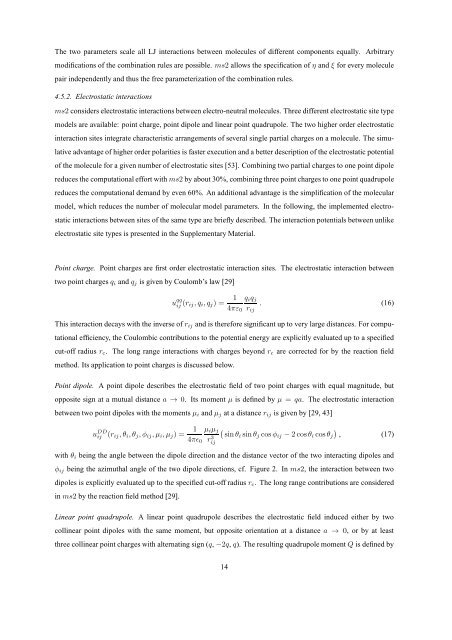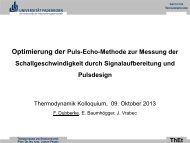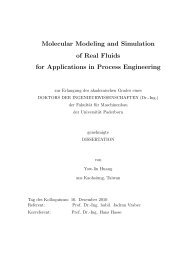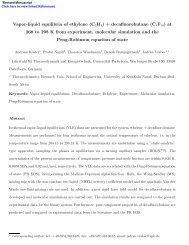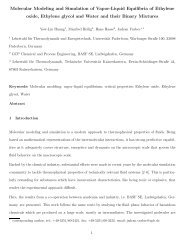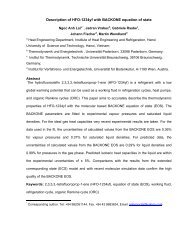ms2: A Molecular Simulation Tool for Thermodynamic Properties
ms2: A Molecular Simulation Tool for Thermodynamic Properties
ms2: A Molecular Simulation Tool for Thermodynamic Properties
Create successful ePaper yourself
Turn your PDF publications into a flip-book with our unique Google optimized e-Paper software.
The two parameters scale all LJ interactions between molecules of different components equally. Arbitrary<br />
modifications of the combination rules are possible. <strong>ms2</strong> allows the specification of η and ξ <strong>for</strong> every molecule<br />
pair independently and thus the free parameterization of the combination rules.<br />
4.5.2. Electrostatic interactions<br />
<strong>ms2</strong> considers electrostatic interactions between electro-neutral molecules. Three different electrostatic site type<br />
models are available: point charge, point dipole and linear point quadrupole. The two higher order electrostatic<br />
interaction sites integrate characteristic arrangements of several single partial charges on a molecule. The simu-<br />
lative advantage of higher order polarities is faster execution and a better description of the electrostatic potential<br />
of the molecule <strong>for</strong> a given number of electrostatic sites [53]. Combining two partial charges to one point dipole<br />
reduces the computational ef<strong>for</strong>t with<strong>ms2</strong> by about 30%, combining three point charges to one point quadrupole<br />
reduces the computational demand by even 60%. An additional advantage is the simplification of the molecular<br />
model, which reduces the number of molecular model parameters. In the following, the implemented electro-<br />
static interactions between sites of the same type are briefly described. The interaction potentials between unlike<br />
electrostatic site types is presented in the Supplementary Material.<br />
Point charge. Point charges are first order electrostatic interaction sites. The electrostatic interaction between<br />
two point chargesqi andqj is given by Coulomb’s law [29]<br />
u qq<br />
ij (rij,qi,qj) = 1 qiqj<br />
4πε0 rij<br />
. (16)<br />
This interaction decays with the inverse ofrij and is there<strong>for</strong>e significant up to very large distances. For compu-<br />
tational efficiency, the Coulombic contributions to the potential energy are explicitly evaluated up to a specified<br />
cut-off radius rc. The long range interactions with charges beyond rc are corrected <strong>for</strong> by the reaction field<br />
method. Its application to point charges is discussed below.<br />
Point dipole. A point dipole describes the electrostatic field of two point charges with equal magnitude, but<br />
opposite sign at a mutual distance a → 0. Its moment µ is defined by µ = qa. The electrostatic interaction<br />
between two point dipoles with the momentsµi andµj at a distancerij is given by [29, 43]<br />
u DD<br />
ij (rij,θi,θj,φij,µi,µj) = 1<br />
4πǫ0<br />
µiµj<br />
r3 <br />
sinθisinθj cosφij −2cosθicosθj , (17)<br />
ij<br />
with θi being the angle between the dipole direction and the distance vector of the two interacting dipoles and<br />
φij being the azimuthal angle of the two dipole directions, cf. Figure 2. In <strong>ms2</strong>, the interaction between two<br />
dipoles is explicitly evaluated up to the specified cut-off radius rc. The long range contributions are considered<br />
in<strong>ms2</strong> by the reaction field method [29].<br />
Linear point quadrupole. A linear point quadrupole describes the electrostatic field induced either by two<br />
collinear point dipoles with the same moment, but opposite orientation at a distance a → 0, or by at least<br />
three collinear point charges with alternating sign (q,−2q,q). The resulting quadrupole momentQ is defined by<br />
14


